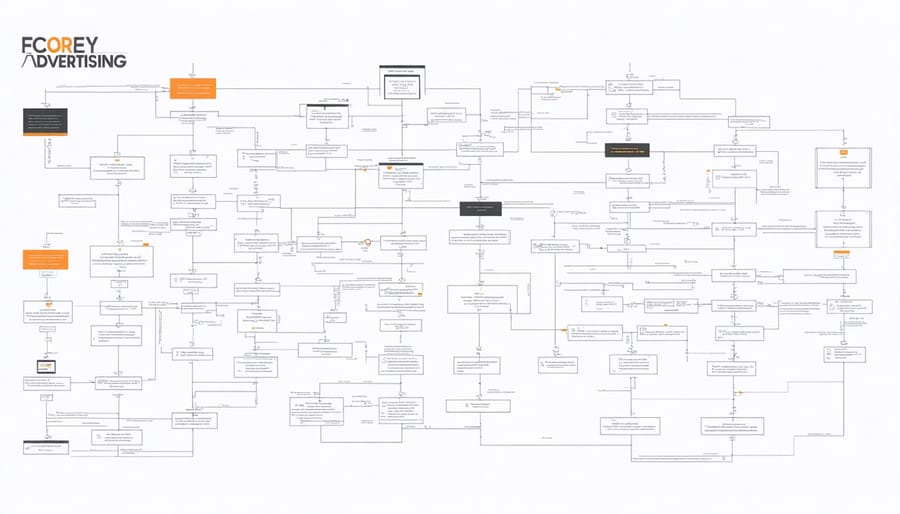Blockchain Technology Makes Digital Ad Spending Finally Make Sense

Transparency advertising revolutionizes how brands build trust and demonstrate accountability in the digital age. By leveraging blockchain technology and AI-driven marketing solutions, businesses can now provide unprecedented visibility into their advertising operations, from media buying to performance metrics.
The shift towards transparent advertising practices isn’t just about compliance—it’s a strategic advantage. Studies show that 94% of consumers are more likely to remain loyal to brands that offer complete transparency. This approach transforms traditional advertising by eliminating intermediaries, reducing fraud, and creating verifiable data trails that benefit both advertisers and consumers.
For businesses seeking to maintain competitive edge, transparency advertising represents the intersection of trust-building and technological innovation. It enables real-time tracking of ad spend, verification of ad placement, and authentic engagement metrics—all while meeting growing consumer demands for ethical business practices.
This evolution in advertising technology offers a clear path to improved ROI, enhanced brand reputation, and stronger customer relationships. By embracing transparency, businesses position themselves at the forefront of a movement that’s reshaping the future of digital marketing.
The Current State of Digital Ad Transparency
Major Pain Points in Digital Advertising
Digital advertisers face several critical challenges that undermine campaign effectiveness and ROI. The most pressing issue is the lack of data transparency, where advertisers struggle to verify if their ads are reaching real humans rather than bots. This opacity extends to campaign performance metrics, making it difficult to assess true advertising value.
Another significant pain point is the complexity of the advertising supply chain. With multiple intermediaries between advertisers and publishers, tracking ad spend and ensuring proper placement becomes increasingly challenging. This fragmentation often leads to higher costs and reduced efficiency in personalized customer targeting.
Ad fraud remains a persistent concern, with sophisticated schemes draining advertising budgets through fake impressions and clicks. Industry estimates suggest that billions are lost annually to fraudulent activities, eroding advertiser confidence and campaign effectiveness.
Measurement inconsistencies across platforms and providers create additional headaches. Different reporting methodologies and metrics make it difficult to compare campaign performance accurately or make data-driven decisions. This challenge is compounded by limited access to raw data and detailed performance insights, hampering optimization efforts and strategic planning.

The Real Cost of Advertising Opacity
The lack of transparency in advertising isn’t just an inconvenience – it’s a significant financial drain on businesses. Studies show that up to 30% of advertising budgets are wasted due to unclear reporting, fraudulent activities, and inefficient spending. For a company investing $100,000 in digital advertising annually, this translates to a potential loss of $30,000.
Hidden fees and undisclosed markups from advertising intermediaries further compound these costs. Many businesses unknowingly pay premium rates for ad placements while receiving subpar results due to opacity in the media buying process. Additionally, the inability to track ad performance accurately leads to misallocation of resources and missed optimization opportunities.
The ripple effect extends beyond direct financial losses. Time spent reconciling inconsistent reports, investigating discrepancies, and managing multiple vendor relationships adds substantial operational costs. Companies often need to hire additional staff or consultants to navigate complex advertising ecosystems, further increasing their overhead.
These challenges particularly impact small and medium-sized businesses, who lack the resources to implement sophisticated tracking systems or negotiate better terms with advertising platforms.
How Blockchain Transforms Ad Transparency
Smart Contracts and Ad Verification
Smart contracts are revolutionizing ad verification by creating automated, tamper-proof systems for tracking ad delivery and ensuring transparent payments. These self-executing contracts, built on blockchain technology, automatically verify when ads are displayed, track viewer engagement, and process payments when predetermined conditions are met.
The process works through a series of programmed checkpoints. When an advertiser launches a campaign, the smart contract holds the advertising budget in escrow. As ads are served to viewers, the contract automatically records key metrics such as impressions, clicks, and engagement time. Once these metrics are verified through consensus mechanisms, the contract releases payment to publishers without any manual intervention.
This automation eliminates several traditional pain points in advertising. First, it removes the need for third-party verification services, reducing costs and potential conflicts of interest. Second, it provides real-time transparency, allowing advertisers to monitor their campaign performance instantly. Third, it ensures publishers receive timely payments based on actual, verified ad deliveries.
Smart contracts also help combat ad fraud by establishing immutable records of ad transactions. Each interaction is recorded on the blockchain, making it virtually impossible to falsify impressions or manipulate engagement metrics. This creates a trustworthy environment where both advertisers and publishers can operate with confidence.
For businesses implementing smart contracts in their advertising operations, the benefits include reduced administrative overhead, faster payment processing, and improved campaign accountability. The system also provides detailed audit trails, making it easier to analyze campaign performance and optimize future advertising strategies.
While the technology is still evolving, smart contracts represent a significant step forward in creating a more transparent and efficient advertising ecosystem.
Real-Time Tracking and Reporting
Blockchain technology revolutionizes how businesses track and measure their advertising performance by providing unprecedented real-time visibility into campaign metrics. Unlike traditional advertising systems that often involve delayed reporting and potential discrepancies, blockchain-based platforms offer immediate, verifiable data that helps organizations optimize their data-driven marketing strategies on the fly.
This real-time tracking capability enables advertisers to monitor key performance indicators (KPIs) such as impression delivery, click-through rates, and conversion metrics as they happen. Each advertising interaction is recorded as a transaction on the blockchain, creating an immutable audit trail that eliminates concerns about data manipulation or reporting inaccuracies.
The system automatically validates and records every ad impression, click, and conversion, providing advertisers with a comprehensive view of their campaign performance. This transparency allows for quick identification of ineffective placements, fraudulent activities, or underperforming segments, enabling immediate optimization of advertising spend.
Real-time reporting through blockchain also streamlines the reconciliation process between advertisers, agencies, and publishers. Instead of waiting for end-of-month reports and dealing with discrepancies, all parties have access to the same verified data set, significantly reducing payment disputes and administrative overhead.
Additionally, smart contracts can automate performance-based payments, ensuring that advertisers only pay for verified impressions and genuine engagement. This automated settlement process not only increases efficiency but also builds trust between all parties involved in the advertising ecosystem.
For businesses looking to maximize their advertising ROI, blockchain’s real-time tracking and reporting capabilities provide the transparency and accountability needed to make informed decisions quickly and confidently.

Implementing Blockchain-Based Ad Transparency
Getting Started with Blockchain Ad Platforms
To begin implementing blockchain advertising solutions, first identify your specific transparency needs and goals. Start by researching reputable blockchain ad platforms that align with your business objectives – popular options include AdLedger, AdEx, and Basic Attention Token (BAT).
Next, create an account on your chosen platform and complete the verification process. Most platforms require basic business documentation and cryptocurrency wallet setup. Consider working with a blockchain technology consultant if you’re new to the space.
Implement the platform’s tracking codes or APIs into your existing advertising infrastructure. This typically involves adding JavaScript snippets to your website and integrating with your current ad management system. Many platforms provide detailed documentation and support for this process.
Start small with a test campaign to understand the platform’s features and metrics. Monitor key performance indicators like impression verification, click authenticity, and fraud detection rates. Use this data to optimize your campaigns and adjust your strategy accordingly.
Establish clear reporting protocols to track the benefits of blockchain-based advertising. Focus on metrics that demonstrate improved transparency, such as verified ad delivery, reduced fraud rates, and accurate audience targeting.
Finally, gradually scale your blockchain advertising efforts based on initial results. Keep your team updated on best practices and new features as platforms evolve. Regular training and optimization will help maximize your return on investment in blockchain advertising technology.

Measuring Success and ROI
Measuring the success of transparency advertising requires a comprehensive approach combining traditional metrics with blockchain-specific indicators. Start by establishing baseline KPIs including click-through rates, conversion rates, and cost per acquisition. These metrics, when integrated with advanced marketing analytics, provide valuable insights into campaign performance.
Track blockchain-specific metrics such as smart contract execution rates, verification speed, and data authenticity scores. Monitor the percentage of verified ad placements against total impressions to gauge transparency levels. Calculate cost savings from reduced fraud and intermediary elimination to determine direct ROI impact.
Customer trust indicators serve as crucial success metrics. Measure changes in brand sentiment, customer feedback scores, and trust-related engagement metrics before and after implementing transparency protocols. Document increases in repeat business and customer lifetime value that correlate with enhanced transparency measures.
Create a dashboard that combines these metrics to generate a transparency score. This score should reflect both quantitative data (verification rates, response times) and qualitative feedback (customer satisfaction, brand perception). Regular reporting cycles help identify trends and optimization opportunities.
Remember to factor in implementation and maintenance costs when calculating ROI. Include savings from reduced ad fraud, improved targeting efficiency, and enhanced customer trust in your calculations. This comprehensive approach ensures accurate measurement of your transparency advertising initiatives.
Future Implications for Digital Advertising
Emerging Trends and Technologies
Blockchain technology continues to reshape the advertising landscape, introducing innovative solutions for transparency and accountability. Smart contracts are emerging as a game-changing tool, automatically enforcing advertising terms and payments while providing real-time verification of ad delivery and performance metrics.
Decentralized advertising platforms are gaining traction, enabling direct connections between advertisers and publishers without intermediaries. These platforms utilize blockchain’s immutable ledger to track ad impressions, clicks, and conversions with unprecedented accuracy, effectively reducing ad fraud and ensuring more accurate campaign reporting.
Another significant development is the integration of zero-knowledge proofs, allowing advertisers to verify campaign performance without compromising user privacy. This technology enables compliance with data protection regulations while maintaining transparent advertising practices.
Token-based advertising ecosystems are also on the rise, introducing new ways to incentivize user engagement and reward authentic interactions. These systems use cryptocurrency tokens to create transparent value exchanges between advertisers, publishers, and consumers.
Machine learning algorithms combined with blockchain are enhancing targeting capabilities while maintaining transparency. These systems can analyze patterns and optimize ad placement while providing clear audit trails of their decision-making processes.
Looking ahead, cross-chain interoperability solutions are being developed to enable seamless advertising operations across different blockchain networks, potentially creating a unified, transparent advertising ecosystem that spans multiple platforms and channels.
Preparing Your Business for the Change
To successfully adapt to transparency advertising, start by auditing your current advertising practices and data collection methods. Create a comprehensive inventory of your marketing channels, data sources, and reporting systems to identify areas that need enhanced transparency.
Implement robust data tracking and verification systems that can monitor and record all advertising transactions and metrics in real-time. Consider investing in blockchain-enabled advertising platforms that automatically create immutable records of ad placements, impressions, and engagement metrics.
Develop clear documentation protocols for all advertising campaigns, including detailed records of targeting parameters, creative assets, and performance metrics. This documentation should be easily accessible to stakeholders and ready for audit when needed.
Train your marketing team on transparency best practices and ensure they understand the importance of accurate reporting and data verification. Establish standard operating procedures for data collection, verification, and reporting that align with transparency requirements.
Update your client communication strategies to emphasize transparency. Create regular reporting templates that clearly show advertising performance metrics, spending allocation, and ROI calculations. Consider implementing a client portal where stakeholders can access real-time campaign data and performance metrics.
Finally, review and update your privacy policies and data handling procedures to ensure compliance with transparency requirements while protecting sensitive information. Regularly assess your transparency measures and adjust them based on industry standards and stakeholder feedback.
Remember to maintain open communication channels with your advertising partners and technology providers to stay informed about new transparency tools and best practices as they emerge.
Transparency advertising represents a significant shift in how businesses approach their marketing efforts, leveraging blockchain technology to create more trustworthy and effective campaigns. As we’ve explored throughout this article, implementing transparent advertising practices not only builds consumer trust but also delivers measurable business benefits through improved ROI and reduced ad fraud.
The key to successful implementation lies in taking a systematic approach: start by auditing your current advertising processes, identify areas where transparency can add value, and gradually integrate blockchain-based solutions. Remember that transparency isn’t just about technology – it’s about building authentic relationships with your audience through honest communication and verifiable claims.
For businesses looking to embrace transparency advertising, we recommend:
– Starting with a pilot program in one advertising channel
– Investing in proper tracking and verification tools
– Training team members on blockchain basics and transparency principles
– Regularly communicating transparency initiatives to stakeholders
– Measuring and analyzing results to optimize performance
The future of advertising is undoubtedly moving toward greater transparency, driven by both consumer demand and technological capabilities. By adopting these practices now, businesses can position themselves ahead of the curve while building stronger, more trusted relationships with their audiences.
Remember that transparency advertising is an ongoing journey rather than a destination. Stay informed about emerging technologies, maintain open dialogue with your customers, and continuously refine your approach based on results and feedback.
Leave a Reply